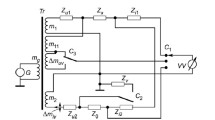A brief overview is given of the standards required for serial production of LAN cables of various categories. It is shown that for twisted-pair LAN cables category 5e and higher, it is necessary to complete development of the procedure for measurement of key frequency responses (in particular, determining the frequency dependence of the actual value of wave resistance), regulated by the operative GOST R 54429-2011. The reason for the errors of network analyzers are revealed as the effect of the extended cutting section; and the hypothesis that it is impossible to eliminate it within the framework of existing models is substantiated. A hypothesis is formulated about the interference of signals reflected from the beginning of the twisted pair and from the place of its entry into the shell as the primary reason for the distortion of the results of practical measurements. Experimental data confirming the correctness of the proposed assumptions is presented. Modernization of the calibration procedure of the measurement system is proposed, without updating the hardware and software of the vector network analyzer (VNA). The required result is achieved by using a distributed calibration load, individualized for each type of cable, based on a segment of a twisted pair that is manufactured in a production laboratory. It is shown using calculated data and measurement results that the use of such a load reduces from 14 to 3% the methodological measurement error of the impedance of the widespread category 5e cables. The results obtained are invariant to the type of measurement system and can be used in production testing of modern LAN cables of higher categories.




Similar content being viewed by others
Notes
GOST R 54429-2011. Symmetric communications cables for digital transmission systems. General technical specifications.
GOST R 53245-2008. Information technologies. Structured coble systems. Mounting of the main units of the system. Methods of testing.
GOST R 53246-2008. Information technologies. Structured coble systems. Design of the main units of the system. General provisions.
References
I. Frolov and N. Lushenkova, New Russian copper core cables for SCS and access networks, Pervaya Milya, No. 8, 26–29 (2019), https://doi.org/10.22184/2070-8963.2019.85.8.26.29.
V. Andreev, A. Bulkhin, B. Popov, and V. Popov, Quality of LAN cables — The basis for reliable work of SCS and BBA networks, Pervaya Milya, No. 1, 34–37 (2020), https://doi.org/10.22184/2070-8963.2020.86.1.34.37.
A. Semenov and M. Sholudenko, A new standard for twisted pair communication cables for digital transmission systems," Vestn. Sviazy, No. 9, 43–45, (2012).
D. Mastkevich, "There is a Russian SCS standard...," LAN Network Solutions Magazine, No. 1, 34–37 (2010).
A. Semenov, A. Makuev, and B. Fomichev, Category 8 structured cabling system, Pervaya Milya, No. 5, 58–62 (2016).
R. Kuznetsov, A. Lobanov, and N. Molchanov, Cables Wires, No. 2, 10–24, (2021).
L. Van Rysselberghe, W. Klein, D. Gigon, et al., Review of procedures to overcome spurious eff ects in the measurement of RF communication cables, Cables Wires, No. 2, 26–33 (2021), https://doi.org/10.52350/2072215X_2021_2_26.
A. Kocherov, A. Semenov, and V. Rudenko, Electrical parameters of LAN cables: How we should reorganize control, Pervaya Milya, No. 7, 44–55 (2021).
D. Ya. Galperovich and Yu. V. Yashnev, Vysokockorostnye kabelnye sistemy dlya komputernykh setej (High-Speed Cable Systems for Computer Networks), Russkaja Panorama Publ., Moscow (1999).
Author information
Authors and Affiliations
Corresponding author
Additional information
Translated from Izmeritel’naya Tekhnika, No. 9, pp. 57–62, September, 2022.
Rights and permissions
Springer Nature or its licensor (e.g. a society or other partner) holds exclusive rights to this article under a publishing agreement with the author(s) or other rightsholder(s); author self-archiving of the accepted manuscript version of this article is solely governed by the terms of such publishing agreement and applicable law.
About this article
Cite this article
Kocherov, A.V., Semenov, A.B., Rudenko, V.I. et al. Reduction of the Methodological Error in Measuring the Frequency Response of the Impedance of Twisted Pairs. Meas Tech 65, 679–685 (2022). https://doi.org/10.1007/s11018-023-02139-3
Received:
Accepted:
Published:
Issue Date:
DOI: https://doi.org/10.1007/s11018-023-02139-3




